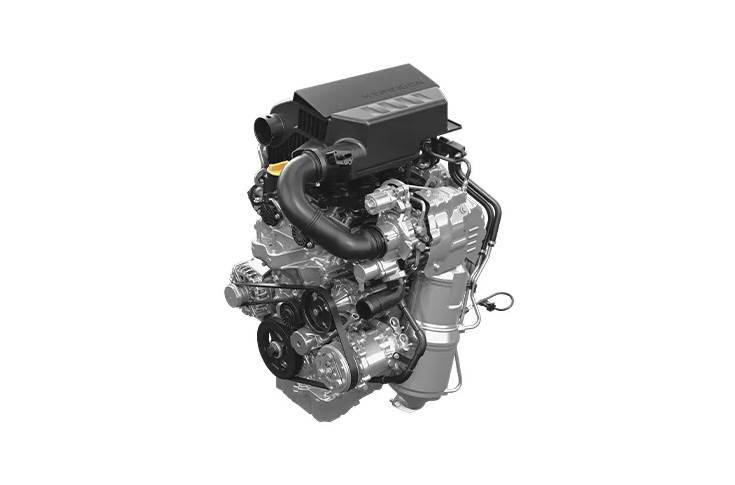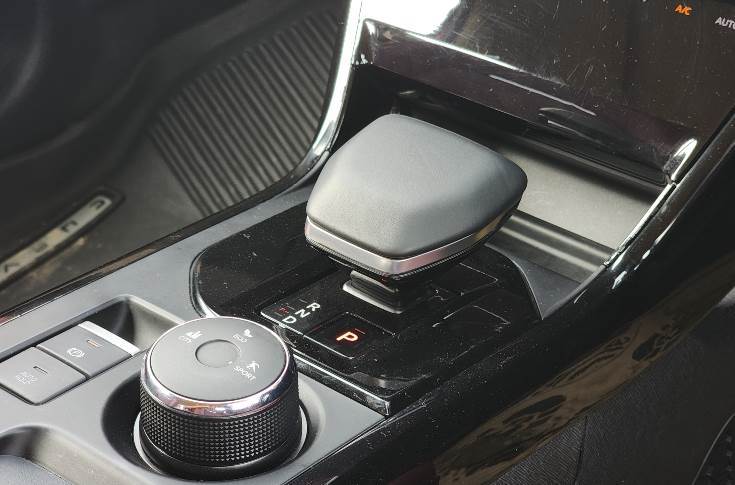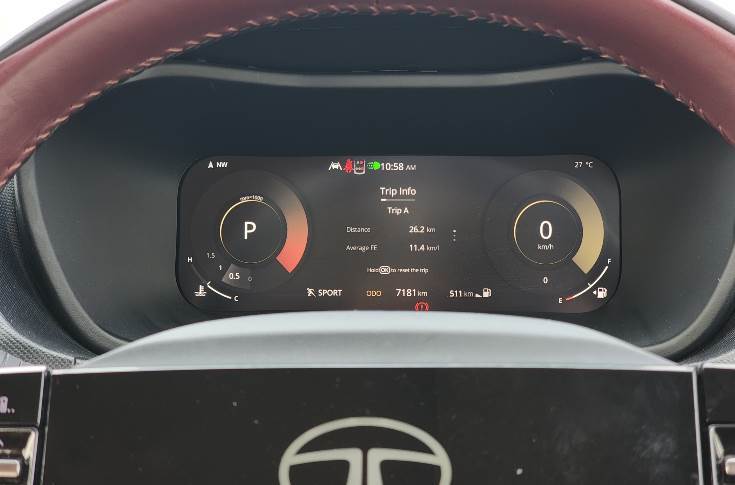Tata Motors, the No. 3 carmaker in India’s competitive passenger vehicle market, has been revving up its game to inch ahead of arch rival Hyundai with a slew of new products that widen appeal across various car segments.
In this endeavour, the company recently unleashed Tata Curvv to take on Hyundai Creta, the undisputed king of the midsize-SUV segment with average monthly sales of nearly 15,500 units during the first half of CY2024.
While the Curvv’s unique, coupé-SUV design is at the centre of Tata Motors’ strategy to challenge Creta’s dominance, the Curvv also comes with a brand-new powertrain that features the company’s maiden gasoline direct injection (GDI) engine. The platform is also expected to help the company meet stringent fuel efficiency and emission norms anticipated in the future.
High-compression (350 bar) GDI engine – Hyperion
The BS-VI and E20-ready 1,199cc, three-cylinder turbocharged petrol engine that was first showcased at the Auto Expo 2023 has been developed to transform the character of petrol-powered Tata Motors cars to deliver a more premium, efficient and engaging driving experience to customers. The new engine, christened ‘Hyperion’, focuses on performance, refinement and efficiency, and features an all-aluminium block to ensure a lightweight yet stiff structure.
Compared to Tata Motors’ existing 1.2-litre Revotron turbocharged petrol engine that does duty in the Nexon, Altroz Racer, and is available as an option on the Curvv as well, the high-compression (350 bar) GDI technology gives the Hyperion completely different performance characteristics.


The direct injection of highly compressed fuel into the combustion chamber, coupled with a variable oil pump, dual-cam phasing and an integrated exhaust manifold in the cylinder head, helps extract 123hp at 5,000rpm, which is 5hp higher than the Revotron that powers the lakhs of Nexon compact SUVs seen on Indian roads.
The new engine also comes with a water-cooled variable geometry turbocharger (VGT) that ensures that the 225Nm of peak torque (55Nm higher than the Revotron mill) gets delivered from as low as 1,700 rpm, and all the way to 3,000 rpm, for a strong mid-range performance. The company has mated the new engine to a six-speed manual or a seven-speed dual-clutch automatic (DCA) transmission.
While the manual transmission drivetrain gets a dual-mass flywheel, there are some vibrations that are still felt when moving the car from a standstill. The typical three-cylinder engine thrum is also audible at lower rpms, whereas the refinement levels increase significantly as the revolutions gain pace.
Although there are three driving modes – Eco, City and Sport – even in the default City mode, the engine offers a smooth power build-up and delivers a good amount of power and torque between 1,800-2,500rpm, making city driving and overtaking a breezy and fun affair.
The light engine construction results in effortless power delivery all the way to the redline, which comes at around 5,800rpm, and coupled with the taut chassis and extremely responsive steering, makes the Curvv a brisk performer in varying driving conditions. However, Tata Motors has kept the gearing on the taller side, thus calling for frequent downshifts in slow-moving traffic, particularly between the first and second gears.
The clutch action in the 6-speed manual variant, while requiring a little effort, has long travel, and the gears shift with a notchy feel, making the overall gear-changing process slightly cumbersome, especially whilst manoeuvring through dense traffic conditions. On the positive side, the Curvv offers brisk acceleration as well as strong stopping power, thanks to disc brakes on all four wheels on the higher variants of the Curvv.
Diesel power mated with DCA – Kryojet
While the new Hyperion mill is likely to rank at the top of the consideration set of buyers looking at the ICE Curvv, Tata Motors has also updated its existing 1.5-litre diesel powertrain and offered it in the Curvv to appeal to buyers with heavier usage. The company has reinforced the engine’s block for better combustion and reduced vibrations.
The 116hp, four-cylinder, turbocharged diesel unit is BS-VI Phase-II compliant and achieves the stringent 80mg/km NOx emission targets with just a Lean NOx Trap (LNT) and passive selective-catalytic reduction (SCR) system. Furthermore, the absence of a diesel particulate filter or DPF makes this diesel engine, christened ‘Kryojet’, the most uncomplicated small-capacity diesel engine in the market today.
 The 1.5-litre diesel unit gets a 6-speed manual transmission as standard, while Tata Motors has also offered the option of a diesel automatic drivetrain, given competitors like the Hyundai Creta and Kia Seltos both offer diesel-automatic choices with torque-convertor transmissions. However, Tata Motors has uniquely mated Punch Powertrain’s dual-clutch automatic transmission (DCA) with the Kryojet diesel mill.
The 1.5-litre diesel unit gets a 6-speed manual transmission as standard, while Tata Motors has also offered the option of a diesel automatic drivetrain, given competitors like the Hyundai Creta and Kia Seltos both offer diesel-automatic choices with torque-convertor transmissions. However, Tata Motors has uniquely mated Punch Powertrain’s dual-clutch automatic transmission (DCA) with the Kryojet diesel mill.
This 7-speed dual-clutch transmission gets a wet-clutch construction and active cooling, thus promising better slow-speed performance and higher longevity, particularly in the stop-and-go Indian driving conditions that typically see high ambient temperatures. Although the transmission offers high levels of driving convenience, the shifts are perceptible, especially in slow-moving traffic when the engine is spinning below the 1,500rpm mark and is in the non-turbo zone.

The driving experience becomes smoother once the revolutions rise, and the gearbox offers seamless shifts as well as brisk performance by transmitting the 260Nm of peak torque being produced by the engine.
Tata Motors’ radical design move
The Hyperion engine on the Curvv transforms it into a keen driver’s car that not only offers an enthralling performance, but also grabs eyeballs with its unique design. While the car looks imposing from the front with its high bonnet that flaunts pronounced muscles, the side profile and rear draw mixed opinions, with a rather polarising design language.

With an aggressively sloping roofline beyond the C-pillar, the Curvv finds an equal number of admirers and critics. Tata Motors admits it will take time for buyers to warm up to the idea of a coupé-SUV, but expects sales to accelerate later. As per Autocar Professional’s analysis, the Curvv ICE and EV have collectively sold 8,218 units in the first three months, until end-October.
While Tata is attempting to offer a fresh new take on mid-size SUVs with the Curvv, the sloping roofline on the coupé-SUV does limit rear headroom, while also significantly restricting rear visibility from the IRVM.
However, to ensure safety, the company has equipped the Curvv with a 360-degree camera as well as a host of Level-II ADAS functionalities, such as adaptive cruise control (only available on the automatic trims), blind-spot detection and autonomous emergency braking (AEB).
The Curvv also offers a high level of refinement when it comes to cabin insulation and NVH, as well as in terms of its ride and handling. The suspension is calibrated to flatten road undulations at high speeds, while the ride quality at slower city speeds has a slightly firm edge to it, particularly owing to the 18-inch wheels. The tall stance, however, offers good visibility of the road and aids manoeuvring through tight spaces.
Stylish and modern interior
On the inside, while the Curvv’s cabin layout largely resembles that of the Nexon, Tata Motors has ensured that the futuristic theme is carried in the interior as well with touches such as a large 12.3-inch floating touchscreen infotainment system sourced from Harman, and the 10.25-inch fully-digital instrument cluster, lending a modern touch.

The company has differentiated the internal-combustion-engine-powered Curvv from the EV by using a darker ‘burgundy’ theme for the cabin, including that on the upholstery and inserts on the dashboard. Ambient lighting, electronic parking brake, and ventilated front seats, which are also electronically adjustable, make the Curvv at par with its key rivals in terms of the feature set. At 500-litre storage capacity, the car also offers best-in-segment boot space with an electric tailgate.
While the front seats might feel smaller to occupants with a larger frame, a nine-speaker JBL audio setup that offers superior sound is a key highlight of the cabin experience, which is further elevated with ample light coming in from the panoramic sunroof. With six airbags and ESC as standard, the Curvv also scores high on safety with a full 5-star crash test rating and a score of 30.81 points out of 32 for adult occupant protection in the BNCAP tests.
Limited practicality
Despite its traditional focus on developing products that cater to the practical needs of customers, Tata Motors seems to have given more emphasis to styling in the Curvv in an attempt to stand out in a rather crowded market. The form-over-function approach in case of certain design features, like the flush outer door handles, limits practicality on a day-to-day basis.
Similarly, the lack of cup holders on the centre console limits storage space inside the cabin. The 10.25-inch digital instrument cluster, which despite being a high-contrast screen, offers poor legibility on the move, owing to the plethora of information being displayed in small font.

The ADAS suite also keeps the autonomous emergency braking or AEB active by default, and given the disorganised Indian traffic conditions, could result in a rear-end collision while attempting to prevent a forward collision. Manually deactivating the AEB requires going into the vehicle settings from the main infotainment screen and turning it off every time the engine is turned on.
The all-touch controls for key functions, such as the hazard light and air recirculation, takes the driver’s attention away from the road. While Tata Motors has taken a huge step forward to integrate modern-day electronics to make the Curvv a futuristic product loaded with technology, the human-machine interface or HMI still has scope for improvement and must aim for less distraction from the road whilst operating several functions inside the car.
 Verdict
Verdict 

However, what comes across as a clear winner for Tata Motors in this entire package is the new 1.2-litre GDI powertrain, which promises ample application opportunities in future products as well. The Hyperion, which is BS-VI Phase-II compliant, is also ready for E20 fuel that is slated to see a nationwide rollout from April 2025. The new mill should also allow the carmaker to achieve its fleet-wide fuel efficiency targets under the Corporate Average Fuel Economy or CAFE-3 norms, set for implementation in 2027.
Moreover, Tata Motors has also paid strong attention to reliability and low maintenance and equipped the new 1.2-litre GDI mill with a timing chain that does not require frequent replacements during periodic vehicle servicing. Although rivals like the Creta, Seltos, Kushaq and Taigun offer more powerful GDI engines, the Hyperion-equipped Curvv will appeal to driving enthusiasts with its value-for-money offering in a fun-to-drive and uniquely styled package.